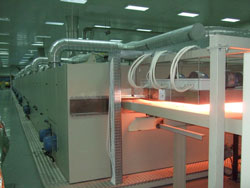Heraeus Infrared Helps Non-Woven Fabrics

Fast response medium wave infrared emitters heat up non-wovens in a quick and efficient way. Copyright Heraeus Noblelight 2011<br>
By installing an infrared heating system from Heraeus Noblelight, Advanced Fabrics (SAAF) has significantly improved the throughput of coated, non-woven fabrics at its Saudi Arabian manufacturing plant to meet increased demands for its products. The system was designed, built and commissioned on-site following extensive trials at Heraeus’ Neston Application Centre.
Heraeus will present infrared heaters for coating, converting and finishing at ICE in Munich, from 8th to 10th November in hall B5 stand 981.
SAAF is a major international force in the medical and hygiene markets for spunbond and SMS nonwovens, produced on state-of-the-art plant. To achieve the specific properties required in medical operations, of being alcohol-repellent and anti-static, fabric manufacture involves the application of a chemical to 100% polypropylene SMS. SAAF’s objective was to increase the throughput of its’ line, whilst maintaining the high quality of application.
After contacting Heraeus, extensive tests were carried out at the company’s Applications Centre. Various combinations of infrared emitters, at various powers were trialled to ensure that sufficient heat for drying could be transferred to the fabric without affecting the polypropylene, which has a low softening and melt point. These tests were then supported with proving trials carried by Heraeus personnel on-site at the Saudi Arabian factory and the results confirmed the suitability of infrared for the application. As a result, the optimum system was installed.
Ian Disley, of SAAF, who was instrumental in selecting the infra-red option and took part in the initial trials, comments, “The Heraeus installation has achieved our target and proved eminently cost-effective.”
Energy Efficiency by Exact Matching
Infrared heating technology offers many possibilities for optimising energy usage in industrial processes:
• High heat transfer capacity
• Contact-free heat transfer
• High efficiency
• Efficient energy transfer by using the optimal wavelength
• Localised energy input by matching the heating to the shape
of the product to be heated
• Time focused energy input because of the rapid response times.
Infrared heat is always used when heating processes need to meet specific requirements in terms of place, time and quality.
Heraeus Noblelight GmbH with its headquarters in Hanau and with subsidiaries in the USA, Great Britain, France, China and Australia, is one of the technology- and market-leaders in the production of specialist light sources. In 2010, Heraeus Noblelight had an annual turnover of 98.9 Million € and employed 689 people worldwide. The organization develops, manufactures and markets infrared and ultraviolet emitters for applications in industrial manufacture, environmental protection, medicine and cosmetics, research, development and analytical measurement techniques
The precious metals and technology group Heraeus headquartered in Hanau, Germany, is a global, family company with 160 years of tradition. Our businesses include precious metals, sensors, dental and medical products, quartz glass, and specialty lighting sources. With product revenues of € 4.1 billion and precious metal trading revenues of € 17.9 billion, as well as over 12,900 employees in more than 120 companies worldwide, Heraeus holds a leading position in its global markets.
For further information please contact:
Technical:
Heraeus Noblelight GmbH
Reinhard-Heraeus-Ring 7
D-63801 Kleinostheim
Tel +49 6181/35-8545, Fax +49 6181/35-16 8545
E-Mail hng-infrared@heraeus.com
Press:
Dr. Marie-Luise Bopp
Heraeus Noblelight GmbH,
Abteilung Marketing/Werbung
Tel +49 6181/35-8547, Fax +49 6181/35-16 8547
E-Mail marie-luise.bopp@heraeus.com
Media Contact
More Information:
http://www.heraeus-noblelight.comAll latest news from the category: Trade Fair News
Newest articles

Properties of new materials for microchips
… can now be measured well. Reseachers of Delft University of Technology demonstrated measuring performance properties of ultrathin silicon membranes. Making ever smaller and more powerful chips requires new ultrathin…

Floating solar’s potential
… to support sustainable development by addressing climate, water, and energy goals holistically. A new study published this week in Nature Energy raises the potential for floating solar photovoltaics (FPV)…

Skyrmions move at record speeds
… a step towards the computing of the future. An international research team led by scientists from the CNRS1 has discovered that the magnetic nanobubbles2 known as skyrmions can be…





















